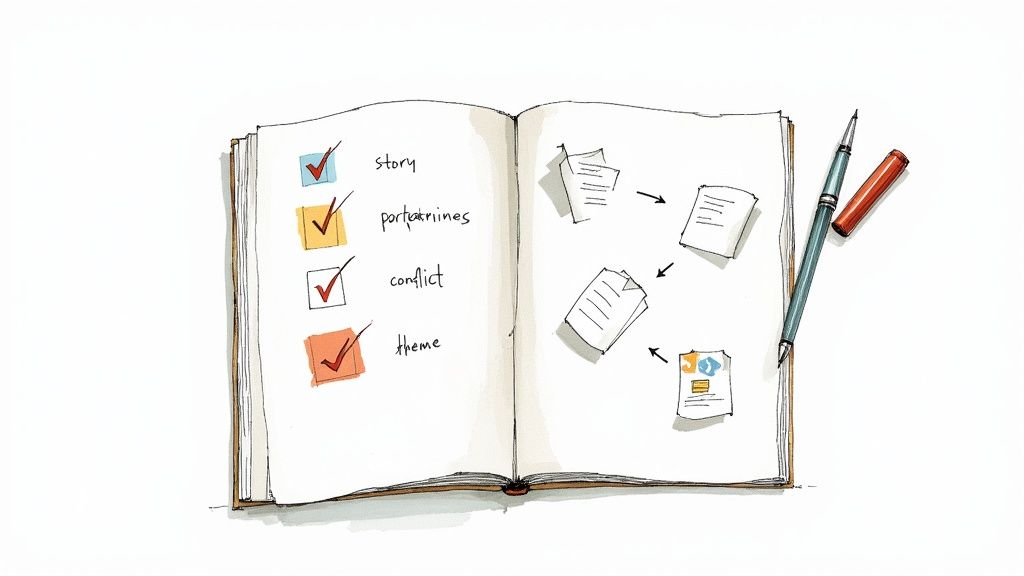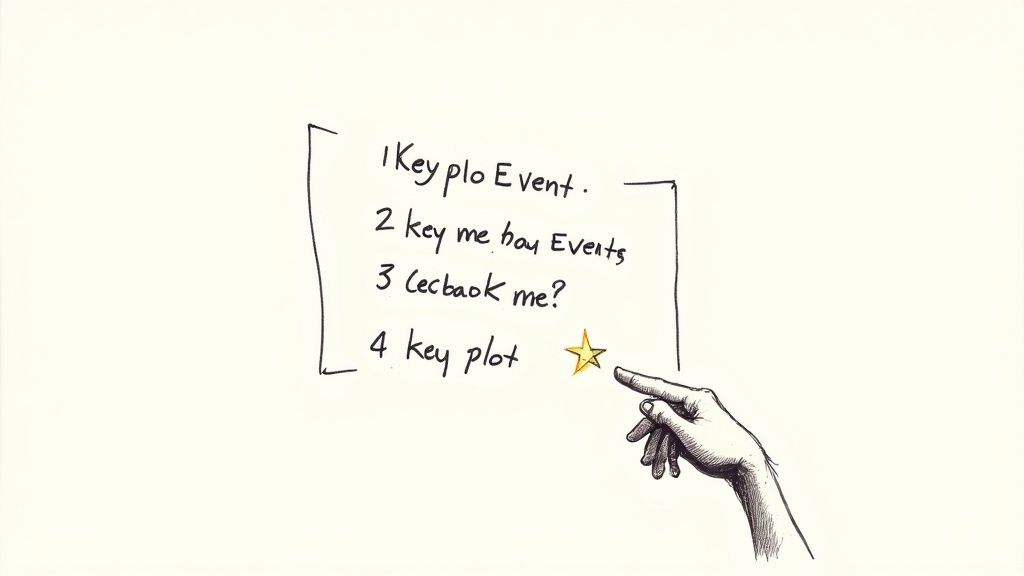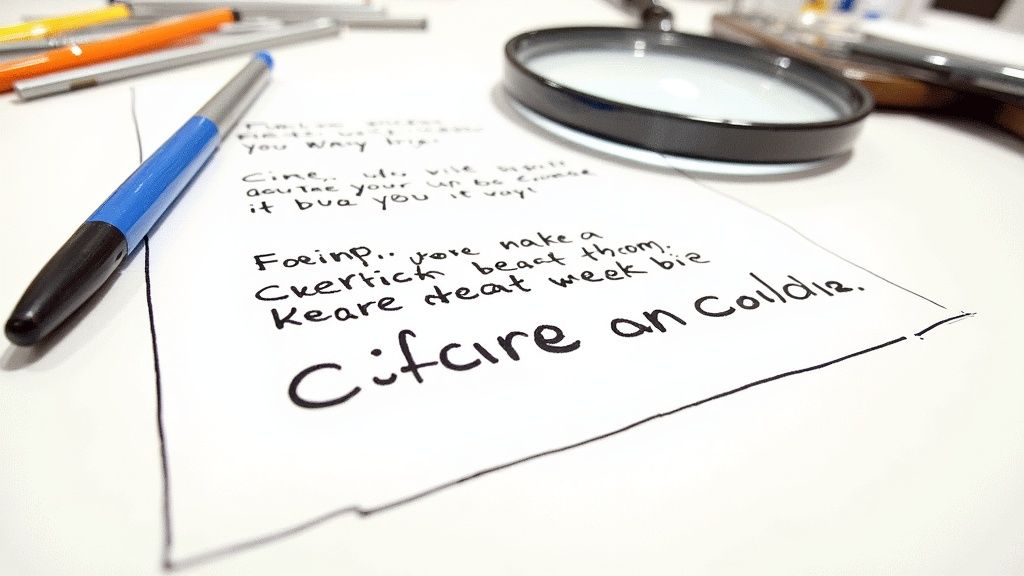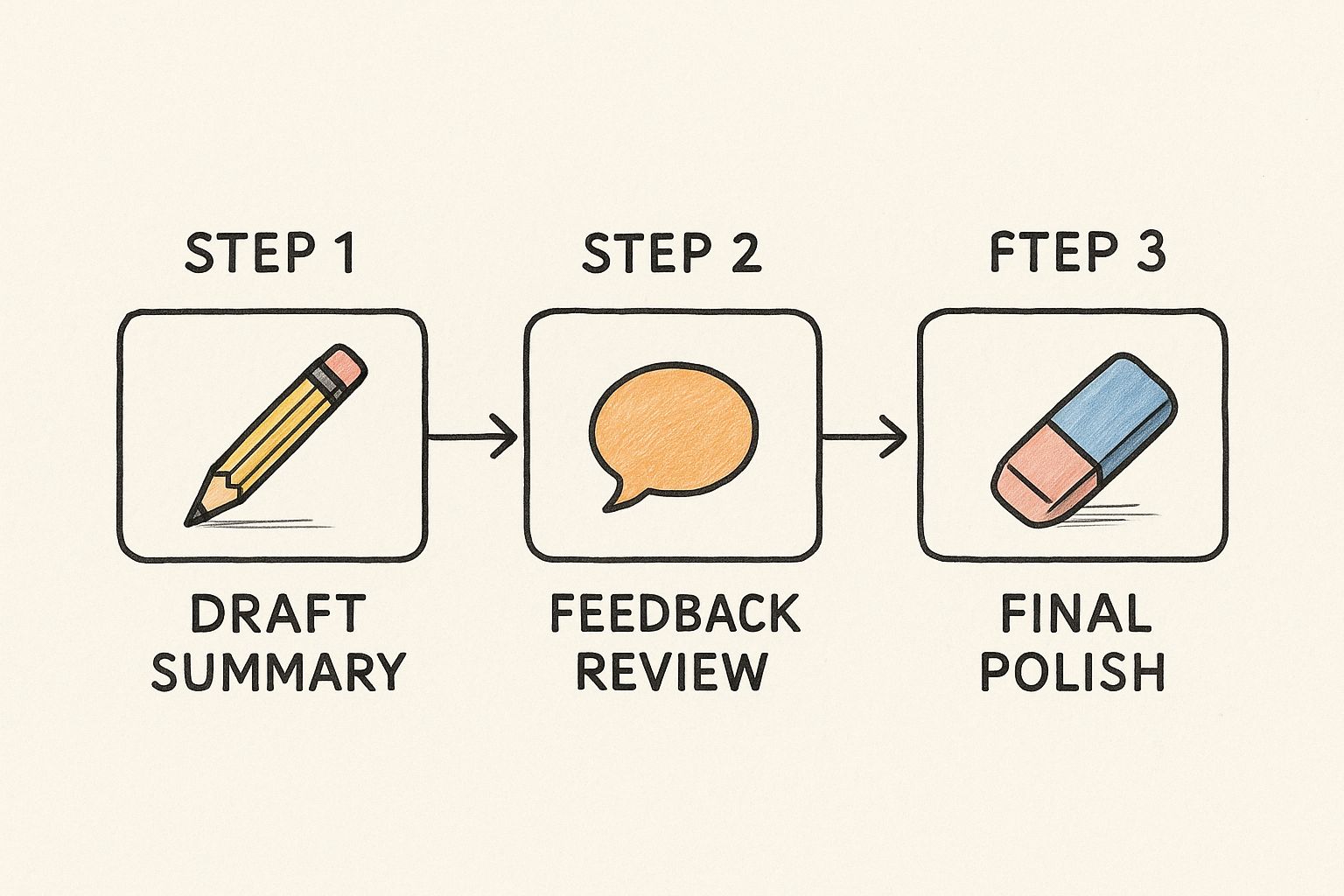How to Write a Novel Summary: A Step-by-Step Guide

Writing a novel summary is much more than just condensing your story. It's about distilling its very essence into a short, magnetic pitch that grabs a reader and refuses to let go. The secret is to pinpoint your protagonist, their driving goal, the core conflict they face, and what’s at stake, then blend those elements into a tight narrative that makes someone need to know what happens next.
Why Your Novel Summary Is Your Most Important Sales Tool

In a world flooded with books, your novel's summary isn't just a brief description—it’s your number one sales tool. Think about it. Before anyone invests hours into your story, they first spend a minute or two on your blurb, whether it's on Amazon, Goodreads, or the physical back cover. That fleeting moment is your single best shot to make a connection and earn a new reader.
This isn't just my opinion; it's a stark market reality. The global books market is enormous, projected to hit USD 156 billion by 2030. In this competitive space, your summary acts as a critical piece of digital real estate. It's what online platforms use to categorize your book, recommend it to new audiences, and ultimately, close the sale.
The Modern Reader Mindset
Let's be honest, readers today are drowning in options. They scroll through endless feeds, their attention pulled in a dozen different directions. Your summary has to be sharp enough to slice through that noise with genuine emotion and intrigue. It can't just list plot points; it has to sell an experience.
To pull this off, you need to put on your marketer hat. A powerful summary should:
- Promise an emotional journey: Will your story make the reader laugh, weep, or grip the edge of their seat? Let them know.
- Create immediate intrigue: Start with a hook. Pose a compelling question or present a fascinating dilemma that begs for a resolution.
- Establish the stakes: Make it crystal clear what your hero stands to lose if they fail.
The purpose of a summary isn't to tell the story; it's to sell the story. It's a hook designed to promise an unforgettable experience, making a reader feel they have to find out what happens next.
Beyond Plot to Pitch
A common trap for authors is writing a detailed synopsis when what they really need is a sales pitch. A synopsis, which you'd send to an agent, meticulously lays out the entire plot from start to finish. A summary—or blurb—is for the reader. Its job is to spark curiosity without spoiling the ending. If you need to write for an agent, you can check out our guide on how to write a synopsis for book for a closer look at that specific format: https://manuscriptreport.com/blog/how-to-write-synopsis-for-book.
To really make your summary shine, it helps to borrow from the principles of understanding personalised content. You're crafting a message designed to connect deeply with your ideal reader. The goal is simple: turn a casual browser into an invested fan by marketing the heart of your story, not just its bones.
Finding the Heart of Your Story Before You Write

Before you even attempt to write a single word of your summary, you have to do something that feels counterintuitive: stop thinking like a writer and start thinking like a reader. Or better yet, a surgeon. You’re far too close to your own manuscript, living and breathing every scene, every minor character, every clever bit of dialogue.
To write a summary that grabs an agent or reader, you need to find the one true throughline—the beating heart of your story. This isn't about making a detailed list of what happens. It's about finding what matters. We're digging for the essential, magnetic core of your novel and leaving the rest on the cutting room floor for now.
Identify the Core Narrative Drivers
Every great story, no matter how complex, can be distilled into a few fundamental drivers. Your first job is to hunt them down within your own pages. Think of these as the load-bearing walls of your narrative; if you took one away, the entire structure would crumble.
Start by asking yourself these brutally simple questions:
- What does my protagonist truly want? Be specific. "Happiness" is not a goal. "To reclaim their family's stolen throne" is. This desire has to be concrete and powerful.
- What is the main thing stopping them? This is your central conflict, the engine that powers your entire plot. It could be a villain, a societal force, or a crippling internal flaw.
- What happens if they fail? The stakes need to be devastatingly high and deeply personal. What’s the worst-case scenario?
By zeroing in on desire, conflict, and stakes, you boil your story down to its most emotionally potent form. This is the bedrock of a summary that will actually hook someone.
Getting a firm grip on these foundational elements is crucial. It’s a key part of understanding the core principles of storytelling that applies across any medium, not just novels.
Pinpoint the Key Plot Arcs
Once you know your core drivers, you can map the major plot points that serve this central story. The key here is to resist the temptation to include every twist and turn. You're looking for the big, story-altering moments. The earthquakes, not the aftershocks.
Think of your book's journey as a skeleton with just a few key bones:
- The Inciting Incident: Find the precise moment where your character's ordinary world shatters, forcing them onto a new path. This is where the story truly begins.
- Major Turning Points: Look for two or three massive escalations. These are the points of no return where the conflict gets significantly worse and the stakes are raised to a terrifying new level.
- The Climax (Hinted): You won’t give away the ending, but you need to know exactly what the final confrontation is. Your summary should build tension toward this ultimate moment, making the reader desperate to know how it all plays out.
Taking the time to isolate these elements before you write your summary is the single most important step. It creates a focused map for your summary, ensuring you’re not just listing events but telling a miniature, compelling story about a character facing impossible odds.
Crafting an Irresistible Opening Line

Let's be honest: your first sentence is everything. It's your one shot to stop someone from scrolling past your book. Think of it as the handshake, the first impression, and the promise of a great story all packed into a dozen or so words. A limp opening gets your summary ignored. A sharp, intriguing one makes a reader pause and lean in.
This isn't just about sounding clever; it’s a crucial sales tactic. The way we write summaries has shifted because reader habits have changed. In fact, some studies show that a whopping 70% of readers decide whether to buy a book based on the summary alone. That’s why so many successful authors lead with a powerful hook. If you want to dig deeper, you can explore more about these evolving reader preferences and see just how much that first line matters.
Connect Your Hook to the Core Conflict
A great hook isn't just a random, shocking sentence. It has to be surgically tied to the very heart of your story—your main character's central problem. It’s a direct teaser of the core conflict, the thing that drives every page of your manuscript.
The goal is to make the reader immediately ask, "Wait, what?" or "How on earth does that get resolved?" It sets up a promise that the rest of your summary—and your novel—will deliver on.
Your opening line's job is to create an immediate question in the reader's mind that can only be answered by reading on. It’s the door to your story; make it irresistible to open.
So, how do you do that? Here are a few angles I've seen work time and time again:
- A Shocking Statement: Drop a startling fact about your character or their world right away. Something like, "The first thing the ghost of his wife told him was that he was next."
- A Provocative Question: Frame the central dilemma as a question that feels impossible to answer. For instance, "How do you prove your innocence when the only witness is the man you're accused of murdering?"
- An Impossible Dilemma: Corner your protagonist with two awful choices from the get-go. Imagine something like, "To save her city, the sorceress had to sacrifice her own magic—the one thing that kept her alive."
The Hook Writing Workshop
Never, ever settle for your first draft of a hook. The real magic happens when you experiment. I always tell authors to run a quick "Hook Writing Workshop" for their own summary. It's simple, but it's incredibly effective.
- Brainstorm Five Hooks: Just get them on paper. Write five totally different opening lines. Use the ideas above—a statement, a question, a dilemma, or anything else that comes to mind. Don't judge them yet.
- Test Them Out: This is the important part. Read them out loud. Even better, send them to a friend or a beta reader with zero context and ask, "Which one makes you want to know more?" Their gut reaction is gold.
- Analyze the Winner: Once you have a favorite, figure out why it works so well. Is it because it perfectly hints at the high stakes? Or does it nail the unique tone of your book?
This little exercise forces you to think like a marketer, not just a writer. It pushes you past a merely good opening to find one that's genuinely captivating, setting the stage for a summary that sells.
You’ve snagged their attention with a killer opening line. Now what? It’s time to build the body of your summary, and this is where the real storytelling happens. You need to connect the dots between your protagonist, their goal, the conflict, and the stakes, turning them from a checklist of elements into a narrative that flows and builds tension.
This isn't just a laundry list of plot points. Think of it as crafting a mini-story that feels alive and urgent. Your job is to use active, punchy language that makes the reader feel the character's struggle, not just read about it.
Introduce the Core Conflict
Right after your hook, drop the reader straight into the action by introducing the primary conflict. This is the big, story-driving problem your protagonist is up against for the entire novel. Get right to it. What's in their way? Who—or what—is the opposing force?
Don't get bogged down in backstory here. Just present the situation as it stands right after the inciting incident kicks everything off.
- For a fantasy novel: "When a rogue sorcerer steals the kingdom's last dragon egg, Elara, a disgraced royal guard, is the only one with the knowledge to track him through the cursed Deadwood."
- For a thriller: "After witnessing a murder committed by a decorated police chief, journalist Finn Carter finds himself hunted by the very people sworn to protect the city."
Both examples quickly establish who the character is, what they're forced to do, and the massive obstacle standing in their way. No fluff, just forward motion.
Escalate the Stakes and Build Suspense
A great summary never stays still—it escalates. Once you've laid out the initial problem, you need to show the reader how things get worse. Hint at a major turning point that raises the stakes and makes the protagonist's journey feel even more desperate. This is what creates that delicious suspense, making the reader lean in and wonder, "How on earth will they get out of this?"
You’re not spoiling the whole book. You're just giving a glimpse of the mounting pressure, moving the story from its initial setup into the chaotic middle.
A strong summary mimics your novel's emotional arc on a micro scale. It needs a setup (the hook), a rising action (the escalating conflict), and a hint of a climax that leaves the reader desperate to know what happens next.
This is all about taking your raw ideas and refining them, step-by-step, into a polished summary that does your story justice.

Ultimately, writing a summary is an iterative process. You’ll draft, get feedback, and polish your words until they shine.
From Passive to Powerful
The difference between a summary that falls flat and one that hooks an agent or reader often boils down to a few critical word choices. Shifting from passive, plot-first language to active, character-driven language is a non-negotiable part of the process.
To see this in action, let's look at how a weak summary can be transformed into something much more compelling.
Summary Transformation From Weak to Strong
| Element | Weak Summary Example (Passive & Vague) | Strong Summary Example (Active & Compelling) |
|---|---|---|
| Protagonist | A man named John is a detective. | Detective John Harding, a man haunted by his last case... |
| Conflict | A series of crimes happen in the city. | ...is pulled into a deadly game of cat-and-mouse with a killer who leaves clues from his own dark past at every crime scene. |
| Stakes | He has to solve the case or bad things will happen. | To stop the murders, Harding must confront the ghosts he’s tried to bury—or become the killer's final masterpiece. |
See the difference? The strong example gives the character a clear, internal motivation, makes the conflict intensely personal, and defines the stakes in a visceral, emotional way. Learning how to write a novel summary that connects on this level is a skill that can truly make or break your book's chances in a crowded market.
Adapting Your Summary for Different Platforms
So you've done the hard work. You’ve wrestled with your story, pinned down its core elements, and crafted a summary that feels powerful and true. That’s a huge win. But here’s something I’ve learned over the years: that one perfect summary is just your starting point. It’s your base recipe.
To really get your novel in front of the right readers, you need to become a master adapter. The summary that grabs a literary agent is not the same one that will stop a reader scrolling through Amazon. Each platform has its own audience, its own rules, and its own unique rhythm. Think of it less as rewriting and more as recalibrating your message for a different room.
Writing for Online Bookstores and Goodreads
When a reader lands on your book's page on Amazon, Barnes & Noble, or Goodreads, your summary has one job: sell the story. This is your direct pitch, and your goal is pure, unadulterated intrigue.
- Hit the Sweet Spot: Keep it between 150-250 words. That’s long enough to introduce the character, the world, and the core conflict, but short enough that you don't lose the skimmers.
- Speak Their Language: Focus entirely on the reader's experience. Use language that signals the genre. If you've written a thriller, make it "heart-pounding." If it's a romance, promise a "swoon-worthy" escape. This isn't the time for subtlety; it's about meeting reader expectations head-on.
- Make It Scannable: Let's be honest, people scan online. Use short paragraphs, bold text for emphasis, and even bullet points to break up the text. Make your key selling points impossible to miss.
This is where you deploy your strongest hook and most evocative language. To really nail this, you might want to dive deeper into our complete guide to book blurbs.
Nailing the Pitch for Web Novel Apps and Social Media
The world of web novels and social media is a completely different beast. On apps like Wattpad or Radish, the entire model often revolves around getting a reader to click right now. The summary isn't just a description; it’s a conversion tool.
On these mobile-first platforms, your summary’s mission is to create an immediate, undeniable urge to tap "Read More."
This means you have to be brutally concise.
- Web Novel Apps: You might only get a few sentences. Forget the full blurb and think in terms of a high-concept logline. Pose a question that readers desperately need answered.
- Social Media (X, Instagram, TikTok): Here, you’re working with even less real estate. Your "one-line pitch" is your best friend. Something like, "A librarian discovers the books she catalogues are rewriting her own future." It's quick, punchy, and packed with curiosity.
Juggling these different versions of your pitch can get chaotic. This is where a social media content calendar becomes a lifesaver. It helps you plan which version of your summary to use where, ensuring your story is always presented in the most compelling way for that specific audience.
Common Questions About Writing Novel Summaries
Even with a solid process, it's completely normal to have questions when you're trying to condense your sprawling manuscript into a few hundred words. It can feel like an impossible task. Let’s walk through some of the most common sticking points I see authors grapple with. My goal is to give you the clarity you need to nail your summary with confidence.
How Much Plot Should I Actually Reveal?
This is the big one, isn't it? The answer is probably less than you think. A great summary should really only cover the first act and give a taste of the second. Your job is to set the stage, not give away the whole show.
Start by grounding us with your protagonist in their ordinary world. Then, hit us with the inciting incident—the moment everything changes—and clearly define their new goal. Establish the central conflict and, most importantly, the stakes. What horrible thing will happen if your hero fails?
Here's the golden rule: Never, ever reveal major twists that happen from the midpoint on. And spoiling the ending is an absolute deal-breaker. Think of your summary as the ultimate movie trailer for your book. You want to build enough tension and curiosity that someone is desperate to read it, not hand them a play-by-play.
Should My Summary Tone Match My Book?
Yes, 100%. This is a non-negotiable part of the process. Your summary is a direct promise to the reader about the experience waiting for them inside the book. If there's a disconnect between the summary's tone and the actual story, you're setting yourself up for a lot of disappointed readers and bad reviews.
- Writing a gritty thriller? Your summary needs to feel tense and dripping with suspense.
- Penned a witty rom-com? It better be charming, funny, and sparkling with personality.
- Crafted an epic fantasy? The language should feel grand, sweeping, and touched with magic.
Make sure the vocabulary and sentence rhythm in your summary echo the prose of your novel. This is how you attract your perfect reader—the one who is actively searching for the exact story you’ve poured your heart into.
What Are the Biggest Mistakes to Avoid?
After reading thousands of summaries, I see the same mistakes pop up over and over again. If you can just sidestep these common traps, your summary will instantly be stronger and more effective than most.
Here are the most frequent blunders:
- Too Many Characters or Subplots: This is the quickest way to create confusion. Just stick to your protagonist and the primary antagonist or the main conflict. Keep it clean and focused.
- Passive Voice and Clichés: Ditch generic phrases like "a tale of love and loss." Be active and specific. Use powerful verbs that convey real action and emotion.
- Asking a String of Rhetorical Questions: One well-placed question can be a great hook. But a series of them ("Will she find the courage? Can he uncover the truth?") comes across as weak and amateurish. State the stakes directly instead.
- Spoiling the Good Stuff: Remember, a summary is a hook, not a book report. Its entire purpose is to create mystery, not solve it.
How Long Should a Novel Summary Be?
The honest answer? It completely depends on where you're using it. For an online retail blurb, like what you’d put on an Amazon or Goodreads page, the sweet spot is 150-250 words. That’s enough space to establish the character and stakes but short enough for someone to scan on their phone.
For other uses, the length will change. A formal query letter to an agent often requires a much longer, more detailed book synopsis. If you need help with that specific format, you can get some great advice on how to write a synopsis for book for agents. On the flip side, for a social media post, you might only have room for a one-sentence logline. Always check the guidelines for whatever platform you're writing for.
Feeling buried under all the marketing materials you need to launch your book? Let ManuscriptReport.com handle the heavy lifting. We can take your manuscript and generate a complete marketing kit—including summaries, blurbs, keywords, ad copy, and social media posts—in just 10 minutes. Stop wrestling with marketing and get back to writing today.
Related Articles

8 Book Description Examples: Proven Formulas That Sell in 2025
Master 8 proven book description formulas with real examples. Learn Hook-Question-Stakes, Character-Journey-Transformation, and more techniques that convert browsers to buyers.

How to Outline a Book A Writer's Guide
Learn how to outline a book with our guide. Discover practical methods for brainstorming, structuring, and refining your plot for a better manuscript.

Master AI for Book Editing: Complete Guide (2025)
Master AI book editing with our complete 2025 guide. Discover top tools, step-by-step processes, and proven strategies to enhance your writing efficiently.